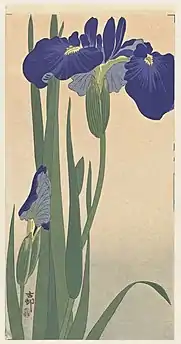Ohara Koson
Ohara Koson (小原 古邨, Kanazawa 1877 – Tokyo 1945) was a Japanese painter and woodblock print designer of the late 19th and early 20th centuries, part of the shin-hanga ("new prints") movement.
.jpg.webp)
Ohara Koson was famous as a master of kachō-e (bird-and-flower) designs. Throughout a prolific career, in which he created around 500 prints, he went by three different titles: Ohara Hōson (小原豊邨), Ohara Shōson (小原祥邨) and Ohara Koson.[1]
Biography
He was born Ohara Matao; it is thought that he started training in painting and design at the Ishikawa Prefecture Technical School in 1889–1893. He also studied painting with Suzuki Kason (1860–1919), although accounts differ on whether this happened during his school years or after he moved to Tokyo in the middle to late 1890s.
In Tokyo, he produced some ukiyo-e triptychs illustrating episodes of the Russo-Japanese War, but most of his production was prints of birds-and-flowers (kachō-e).[2][3] He worked at first with publishers Akiyama Buemon (Kokkeidō) and Matsuki Heikichi (Daikokuya), signing his work Koson. Starting around 1926, he became associated with the publisher Watanabe Shōzaburō, and signed his work Shōson. He also worked with the publisher Kawaguchi, signing his works Hōson.
Through his association with Watanabe, Ohara's work was exhibited abroad, and his prints sold well, particularly in the United States. He was active designing prints until at least 1935, and died at his home in Tokyo in 1945.
His work is held in several museums worldwide, including the Toledo Museum of Art,[2] the Brooklyn Museum,[4] the British Museum,[5] the University of Michigan Museum of Art,[6] the Museum of Fine Arts, Boston,[7] the Harvard Art Museums,[8] the Rijksmuseum,[9] the Carnegie Museum of Art,[10] the Saint Louis Art Museum,[11] the Indianapolis Museum of Art,[3] the Museum of New Zealand,[12] the Museum of Anthropology at the University of British Columbia,[13] the Birmingham Museum of Art,[14] the John and Mable Ringling Museum of Art,[15] and the Clark Art Institute.[16]
References
- Ohara Koson (Shōson) (1877-1945) The Lavenberg Collection of Japanese Prints
- "Herons in Reeds". emuseum.toledomuseum.org. Retrieved 2021-01-07.
- "Pheasant". Indianapolis Museum of Art Online Collection. Retrieved 2021-01-07.
- "Brooklyn Museum". www.brooklynmuseum.org. Retrieved 2021-01-07.
- "print | British Museum". The British Museum. Retrieved 2021-01-07.
- "Exchange: Two white cranes in a stream". exchange.umma.umich.edu. Retrieved 2021-01-07.
- "Water Lilies". collections.mfa.org. Retrieved 2021-01-07.
- Harvard. "From the Harvard Art Museums' collections Kingfisher with Lotus Flower". harvardartmuseums.org. Retrieved 2021-01-07.
- "Mandarijneenden, Ohara Koson, 1925 - 1936". Rijksmuseum (in Dutch). Retrieved 2021-01-07.
- "CMOA Collection". collection.cmoa.org. Retrieved 2021-01-07.
- "Swallows and Wisteria". Saint Louis Art Museum. Retrieved 2021-01-07.
- "Loading... | Collections Online - Museum of New Zealand Te Papa Tongarewa". collections.tepapa.govt.nz. Retrieved 2021-01-07.
- "Collection Online | Museum of Anthropology at UBC". collection-online.moa.ubc.ca. Retrieved 2021-01-07.
- "You are being redirected..." www.artsbma.org. Retrieved 2021-01-07.
- "Crow on Snowy Branch". emuseum.ringling.org. Retrieved 2021-01-07.
- "Nuthatcher atop Persimmons". www.clarkart.edu. Retrieved 2021-01-07.
- Amy Reigle Newland, Jan Perree & Robert Schaap. Koson Ohara - Amsterdam Rijksmuseum, "Crows, Cranes & Camellias. The Natural World of Ohara Koson 1877-1945. Japanese Prints from the Jan Perree Collection". Leiden: Hotei Publishing, 2001. ISBN 90-74822-38-X.
Gallery
 Camellia and Rice Birds, 1929
Camellia and Rice Birds, 1929 Cat and Bowl of Goldfish, 1933
Cat and Bowl of Goldfish, 1933 Crow and Blossom, c. 1910
Crow and Blossom, c. 1910 Five Egrets Descending in Snow, c. 1920s
Five Egrets Descending in Snow, c. 1920s Blue Irises, date unknown
Blue Irises, date unknown